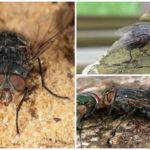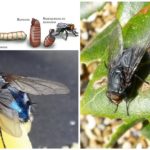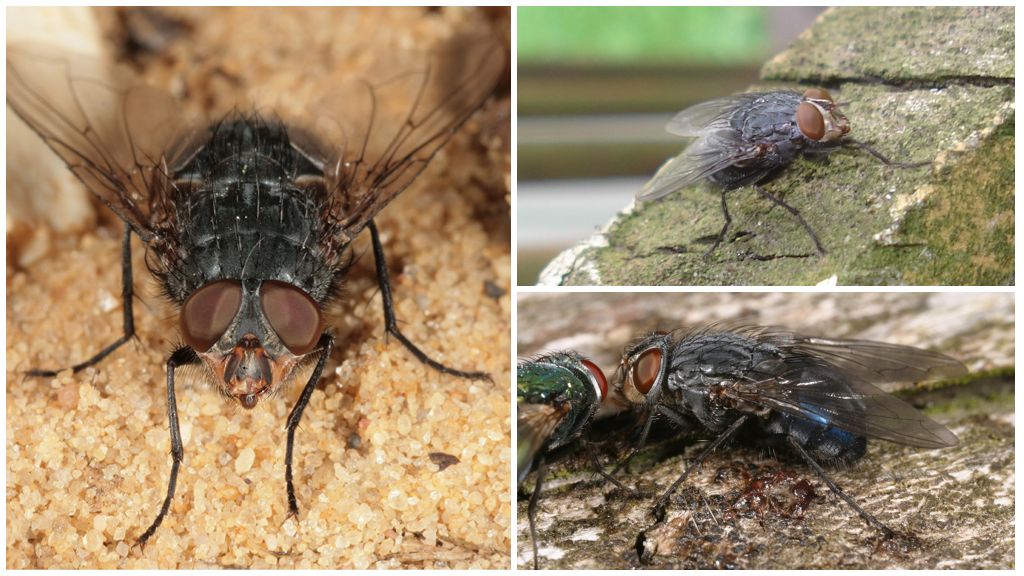Description and photo of a blue meat fly
Content
- Meat Blue Fly
- Meat Blue Fly
The meatfly (Calliphora vicuna), the red-headed callifor or the red-headed blue scab - is a representative of a large family of two-winged insects. In total, there are about 2500 species of such flies, more than three hundred live on the territory of the Russian Federation. In official sources meat flies called sarcophagi, which translated from Greek means "flesh eaters." This name is explained by the fact that the corpses of vertebrate organisms most often serve as a breeding ground for insects. The most common is green and blue fly. The last representative of this type will be discussed in this article.
What it looks like
Blue Meat Fly - the largest from this insect species. The length of her body is about 1.5 cm. She buzzes very loudly when flying, which is very similar to the sound that a bee makes. The body has a blue color with a weak bright touch. On the yellow-red head, casting gold glitter and covered with black hairs, there are dark antennae and facet-type eyes of a red-brown shade.
The chest of the insect is colored black with a bluish tint, with dark longitudinal stripes visible on the mesonotum. The woman has transparent wings that do not overlap at rest.
Where dwells
Calliphora vicuna distributed almost everywhere: throughout Europe, North America, Central Asia and Africa. On the territory of the Russian Federation, a blue meat fly can be found in all forest areas.
About nutrition
Power source for a big blue fly and its larvae, meat of decaying animals, rotting fruits, vegetables and organic matter are used. They are also able to eat the eggs of beetles, other types of flies, caterpillars and grasshoppers.
About reproduction
Lifespan adult in natural conditions does not exceed 20 days.However, during this time, the female manages to give life to two hundred larvae.
After mating, the female finds a suitable place, which is most often served by decaying flesh (animal carcass, fish carcass or remains of decaying organic matter). After 8-25 hours (the period of development depends on the temperature) worm-like larvae appear on the light. They develop in the same substrates where the eggs were laid, undergo 3 molts (ages).
On a note!
At the initial stage of development, the blue fly larva has no mouth apparatus, therefore, it is inherent in extraintestinal digestion. With air temperature indicators of 38–45 degrees, the larvae develop within 3-4 days. Temperatures above 50 degrees are fatal for them. In the event of a third molt, the larva reincarnates into a precolcle, which moves to drier places.
The development of the pupa occurs in the soil at moderate air temperature (20-25 degrees) takes no more than 3-4 days. With high temperature and humidity, the future individual dies.
Puparium formed individual leaves with the help of the frontal bladder. The fly gains activity as its wings dry and gain strength, which usually takes 1.5-2 hours.
With a favorable ambient temperature (+25 degrees) development cycle blue fly lasts no more than two weeks. In the cold season (in a state of inactivity) the life span of flies can be up to 6-7 months. Without food, an individual can exist for no more than 2 days. More resilient in this regard are juveniles. In the event of several days from the moment of emergence from the pupa, the females of the blue fly become sexually mature and capable of fertilization.
About harm
The appearance of a meat fly near the dwelling not only causes an unpleasant feeling of disgust, but also increases the risk of infection with a dangerous infection.
Important!
The most dangerous insect-borne disease is leprosy (leprosy), the most common is intestinal infection. The cause of infection is the alternating contact of the insect with places of pollution and faeces, and subsequently with food and household items.
The blue meat scorch is very harmful for fishermen who hang out salted fish for drying. It annoys the annoying insect and pets, as it can tolerate their diseases, feeding on the corpses of dead animals. No less harmful are the larvae of meat flies, which are the causative agents of miases in humans and animals.
What is useful blue fly
This species causes not only harm, it may be useful for a man. The meat fly lays the larvae with which people have found use. They are especially in demand among anglers who have adapted to fish for maggots. Apply the fly fly larvae and learned in military medicine. In the absence of medicines, maggots were used to treat decaying wounds.
Important!
"Medical" larvae must be sterile and therefore they are specially bred in laboratories.
Here the ability of the larvae to eat dying tissue and keep it alive was useful. For this reason, insects that destroy carrion and rotting organic waste, were attributed to the orderlies of nature.






 (votes: 3, Average rating: 4.67 out of 5)
(votes: 3, Average rating: 4.67 out of 5)


